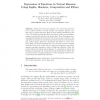Free Online Productivity Tools
i2Speak
i2Symbol
i2OCR
iTex2Img
iWeb2Print
iWeb2Shot
i2Type
iPdf2Split
iPdf2Merge
i2Bopomofo
i2Arabic
i2Style
i2Image
i2PDF
iLatex2Rtf
Sci2ools
97
Voted
ACII
2007
Springer
2007
Springer
Expression of Emotions in Virtual Humans Using Lights, Shadows, Composition and Filters
Abstract. Artists use words, lines, shapes, color, sound and their bodies to express emotions. Virtual humans use postures, gestures, face and voice to express emotions. Why are they limiting themselves to the body? The digital medium affords the expression of emotions using lights, camera, sound and the pixels in the screen itself. Thus, leveraging on accumulated knowledge from the arts, this work proposes a model for the expression of emotions in virtual humans which goes beyond embodiment and explores lights, shadows, composition and filters to convey emotions. First, the model integrates the OCC emotion model for emotion synthesis. Second, the model defines a pixel-based lighting model which supports extensive expressive control of lights and shadows. Third, the model explores the visual arts techniques of composition in layers and filtering to manipulate the virtual human pixels themselves. Finally, the model introduces a markup language to define mappings between emotional s...
| Added | 06 Jun 2010 |
| Updated | 06 Jun 2010 |
| Type | Conference |
| Year | 2007 |
| Where | ACII |
| Authors | Celso de Melo, Ana Paiva |
Comments (0)

